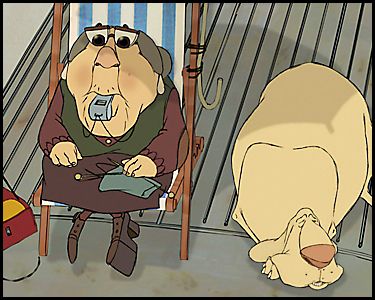|
Reviews of Recent Independent, Foreign, & Documentary Films in Theaters and DVD/Home Video
Directed by: Sylvain Chomet. Produced by: Didier Brunner & Paul Cadieux. Written by: Sylvain Chomet. Edited by: Chantal Colibert Brunner. Music by: Benoît Charest. Released by: Sony Picture Classics. Country of Origin: Canada/France/Belgium/UK. 80 min. Rated: PG-13. Special Features: Selected scenes with commentary. Featurettes: "The Making of The Triplets of Belleville" & "The Cartoon According to Sylvain Chomet." "Belleville Rendez-Vous" music video. Trailer. English/Spanish Audio.
The Simpsons meet William Steig in this vibrantly animated film. A
formidable cub-footed grandmother, Madame Souza, cares for Champion, whose
only companion is his dog Bruno. The boy doesn't seem likely to live up to
his name until his grandmother gives him a present, a bicycle. Having taken
to the bike like a duck to water and with his granny acting as his coach,
Champion, now grown, races through the streets of a changing 1950s Paris.
Rail thin, his beak-like nose making up most of his body weight, he's become
a single-mindedly determined racer. A contender in the Tour de France, he
hasn't gone unnoticed. Before he can complete the race, and while Madame
Souza and Bruno are distracted, he's kidnapped by two shady henchmen dressed
in black. Bruno, following Champion's scent, leads Madame Souza onto a ship
to Belleville, a grandiose and ominous metropolis populated by grotesquely
enormous citizens, where Champion is held captive. Stranded and broke, three
crackling, frog-eating elderly ladies take in the old lady and the humongous
dog. They are the Triplets of Belleville, a musical trio from the '40s. The
unpredictable narrative continues to boomerang, from a music hall number to
a shoot-out with the mob and then to an extended chase sequence. The love
and determination of the grandmother is the heart of the film, but the film
is a far cry from Disney. It's more like a shot of whiskey than saccharine.
Because of the action sequences and the film's coarseness (the bathroom of
the Triplets is vividly depicted, flies and all), Triplets will especially
appeal to boys, 8 to 12. It should also appeal to adults in the mood for a
fast-paced, sophisticated, animated film, even if they are unfamiliar with the
various references to Edith Piaf, Django Reinhardt or Charles de Gaulle. With
virtually no dialogue, this international coproduction should have no
problem crossing borders. KT
DVD Extras: Backstories provided by the disc's mini-documentaries enhances quite significantly
the experience of watching the film. Interestingly, though the filmmakers claim that the fictional
Belleville was meant as an amalgam of New York, Paris, and Montreal, one of the animators
begins, quite startlingly, to refer to a locale in the movie, the French Wine Center, as the
"World...", before correcting himself and making it clear he is talking about the winery.
Additionally in the making-of featurette, much is made of the consumer culture that pervades
Belleville - all conducive to the opinion that, with its obese version of the Statue of Liberty,
Belleville is, in fact, taking direct satirical aim at the United States, or at least its globalization
practices. Chomet's commentary provides insights on bringing the animation to life through a
combination of both visual and aural details, such as creating the sound of Mme. Souza's earrings
whenever they move, or for Bruno's walk. Rounding out the bonuses is a rather odd music video
for the film's quirky Academy Award-nominated theme song - in
which a man, who is presumably one of the song's real-life performers, is shown at his
psychoanalyst's office singing and then appearing in cartoon form next to the triplets in scenes
from the film. Reymond Levy
|
